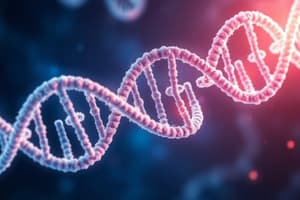Podcast
Questions and Answers
What is the primary function of mRNA in the cell?
What is the primary function of mRNA in the cell?
- To help in the assembly of ribosomes
- To store genetic information permanently
- To transport amino acids to the ribosomes
- To act as a template for protein synthesis (correct)
Which component is NOT part of the structure of mRNA?
Which component is NOT part of the structure of mRNA?
- 5’ cap
- Ribosomal subunits (correct)
- Poly-A tail
- Coding sequence
What type of nucleotides compose mRNA?
What type of nucleotides compose mRNA?
- Amino acids
- Nucleotides from DNA
- Ribonucleotides (correct)
- Deoxyribonucleotides
How does mRNA contribute to genetic diversity?
How does mRNA contribute to genetic diversity?
What are the four nucleobases found in RNA?
What are the four nucleobases found in RNA?
What is the structure that protects mRNA from degradation in eukaryotic cells?
What is the structure that protects mRNA from degradation in eukaryotic cells?
What is the role of codons in mRNA?
What is the role of codons in mRNA?
Which of the following statements about RNA is true?
Which of the following statements about RNA is true?
What is the primary function of tRNA in protein synthesis?
What is the primary function of tRNA in protein synthesis?
Which part of the tRNA structure is responsible for pairing with mRNA codons?
Which part of the tRNA structure is responsible for pairing with mRNA codons?
What role does rRNA play in protein synthesis?
What role does rRNA play in protein synthesis?
Which subunits compose the ribosome in prokaryotes?
Which subunits compose the ribosome in prokaryotes?
How does tRNA ensure the fidelity of protein synthesis?
How does tRNA ensure the fidelity of protein synthesis?
What is a significant characteristic of rRNA across different species?
What is a significant characteristic of rRNA across different species?
What structural feature distinguishes tRNA from other types of RNA?
What structural feature distinguishes tRNA from other types of RNA?
What is the function of mRNA during protein synthesis?
What is the function of mRNA during protein synthesis?
Flashcards are hidden until you start studying
Study Notes
Ribonucleic Acid (RNA)
- RNA is a single-stranded molecule involved in the flow of genetic information.
- RNA is crucial for the central dogma of molecular biology, which describes the flow of genetic information from DNA to RNA to proteins.
- RNA is more versatile than DNA and plays a key role in protein synthesis and gene expression regulation.
- RNA contains four nucleobases: cytosine, guanine, adenine, and uracil.
Messenger RNA (mRNA)
- mRNA is a linear, single-stranded molecule composed of ribonucleotides.
- In eukaryotic cells, mRNA features a 5' cap at the beginning, a coding sequence in the middle, and a poly-A tail at the end.
- These elements protect mRNA from degradation and facilitate its export from the nucleus to the cytoplasm.
- mRNA acts as a template for protein synthesis, carrying genetic instructions from DNA to ribosomes.
- The sequence of codons in mRNA determines the sequence of amino acids in the resulting protein.
- Alternative splicing allows a single gene to produce multiple protein variants.
- Mutations in mRNA can lead to genetic disorders.
Transfer RNA (tRNA)
- tRNA has a distinctive cloverleaf structure, forming an L shape when folded in three dimensions.
- It contains an anticodon loop with a sequence of three nucleotides complementary to mRNA codons.
- tRNA has an amino acid attachment site at the opposite end.
- tRNA is responsible for translating the genetic code in mRNA into amino acids.
- Each tRNA molecule carries a specific amino acid corresponding to the codon on the mRNA.
- During translation, the tRNA anticodon pairs with the complementary mRNA codon, ensuring the correct amino acid is added to the growing polypeptide chain.
- tRNA is essential for accurate translation of genetic information into proteins.
Ribosomal RNA (rRNA)
- rRNA is a structural component of ribosomes, which are made up of rRNA and proteins.
- Prokaryotes have 30S and 50S ribosomal subunits, while eukaryotes have 40S and 60S subunits.
- rRNA within these subunits is highly conserved due to its fundamental role in the cell.
- rRNA helps catalyze the formation of peptide bonds between amino acids during translation.
- rRNA also plays a structural role, ensuring that mRNA and tRNA are properly aligned within the ribosomes.
- rRNA's enzymatic function is crucial for the assembly of proteins.
- rRNA's high conservation across species makes it valuable for evolutionary studies.
Interactions Between mRNA, tRNA, and rRNA
- mRNA provides the genetic instructions for protein assembly.
- tRNA decodes mRNA and delivers the appropriate amino acids.
- rRNA ensures correct alignment and catalyzes bond formation between amino acids.
Studying That Suits You
Use AI to generate personalized quizzes and flashcards to suit your learning preferences.




